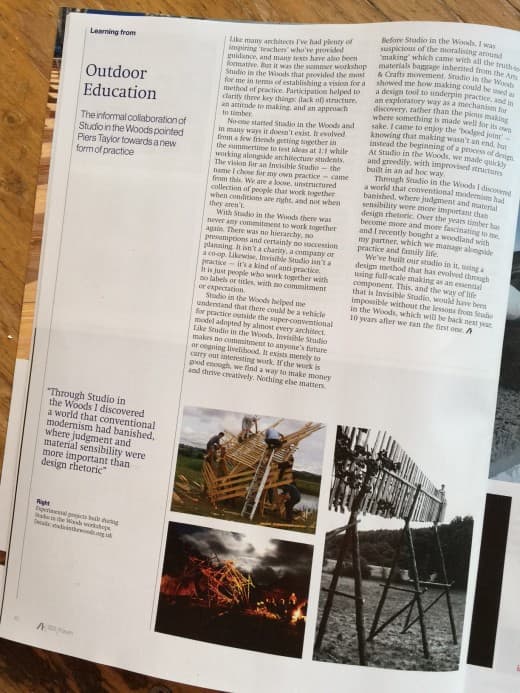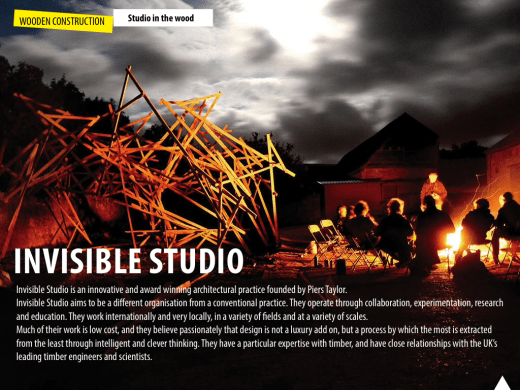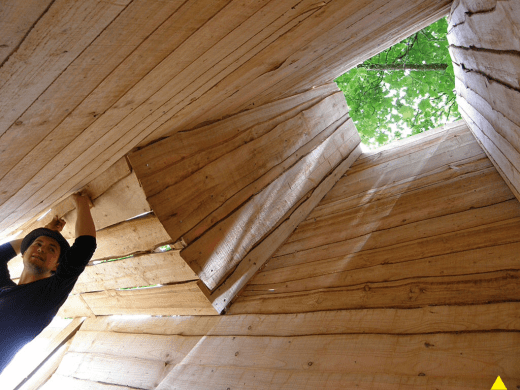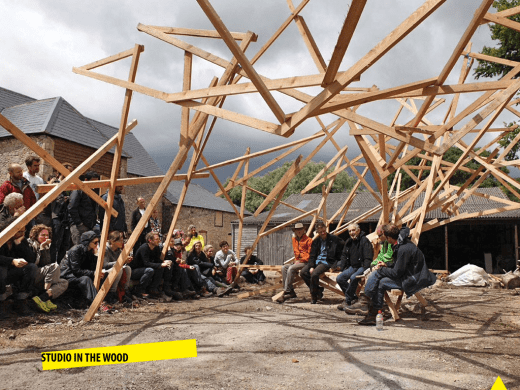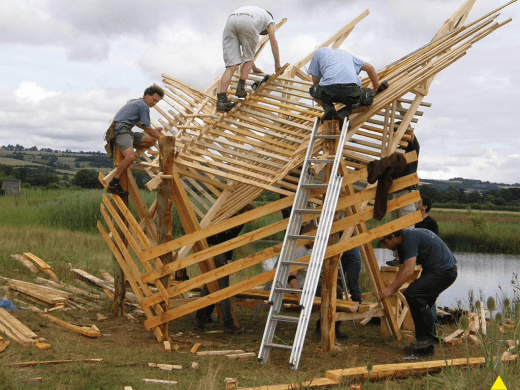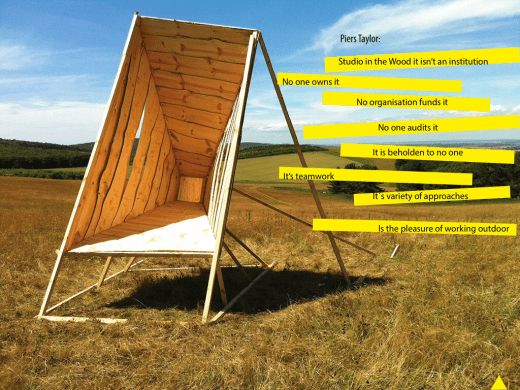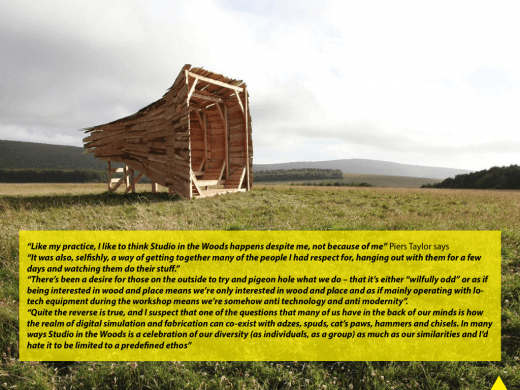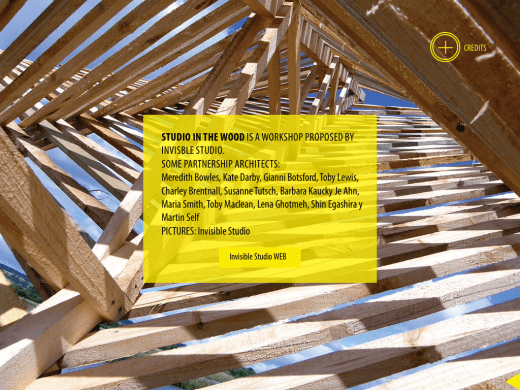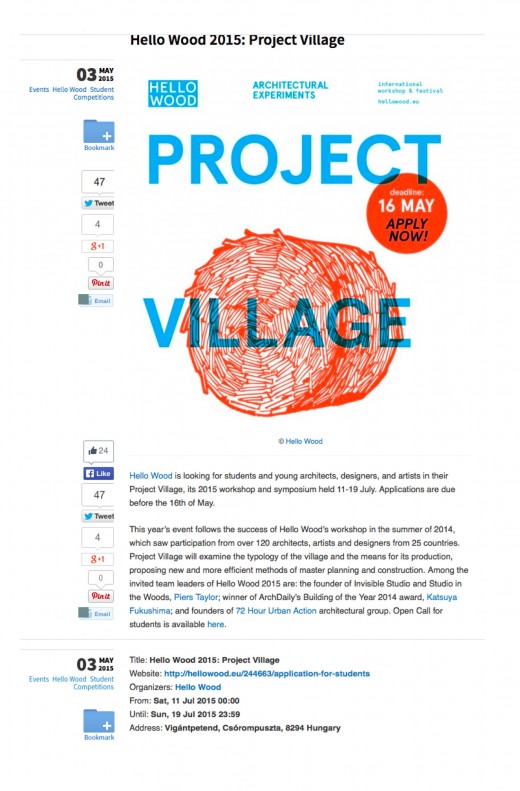
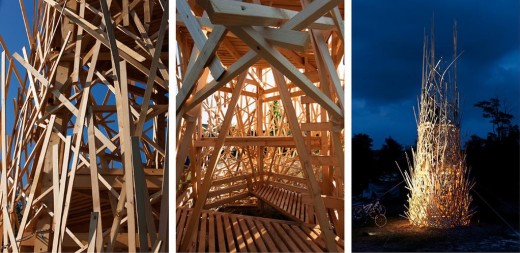 Piers Taylor is participating in this year’s Hello Wood as a workshop leader with Akos Juhasz. For registration, see HERE
Piers Taylor is participating in this year’s Hello Wood as a workshop leader with Akos Juhasz. For registration, see HERE
Hello Wood 2015
On Drawing
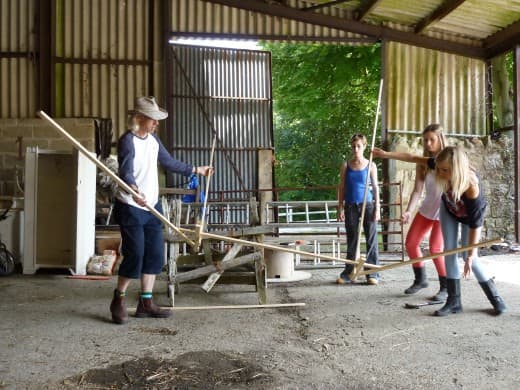
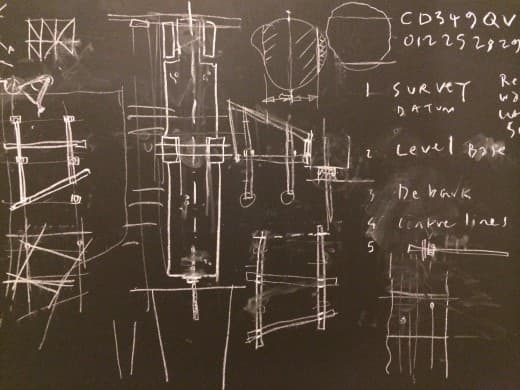 While drawings obviously have a key role in design, they need to be tools to assist and develop the understanding of design, rather than as immutable instructions defining fully the fabrication of a full scale piece. Drawings can take on a different status in a reimagined and reconfigured design process. These drawings are of the are loose, open ended sort, and a correlative part of the process of construction – not fixed before hand and bereft of the real discoveries that take place during fabrication. The conventional architectural drawing idealises construction, and typically uses a strange kind of scaled code to represent an idealised set of relationships where uncertainties and contingencies are impossible. Jonathan Hill, in the ‘Illegal Architect’ talks of how the drawing is used as a control mechanism by architects to eliminate the possibilities of contingencies creeping in. He talks of the ‘artistic creation of an individual in command of a drawing who designs a building in a studio’. While at best drawing is a process that encourages thinking, to the point that at best drawing is thinking – for me it is more exciting when construction is thus, and alongside this, the ‘drawing’ happens in real time, real scale, and in three dimensions.
While drawings obviously have a key role in design, they need to be tools to assist and develop the understanding of design, rather than as immutable instructions defining fully the fabrication of a full scale piece. Drawings can take on a different status in a reimagined and reconfigured design process. These drawings are of the are loose, open ended sort, and a correlative part of the process of construction – not fixed before hand and bereft of the real discoveries that take place during fabrication. The conventional architectural drawing idealises construction, and typically uses a strange kind of scaled code to represent an idealised set of relationships where uncertainties and contingencies are impossible. Jonathan Hill, in the ‘Illegal Architect’ talks of how the drawing is used as a control mechanism by architects to eliminate the possibilities of contingencies creeping in. He talks of the ‘artistic creation of an individual in command of a drawing who designs a building in a studio’. While at best drawing is a process that encourages thinking, to the point that at best drawing is thinking – for me it is more exciting when construction is thus, and alongside this, the ‘drawing’ happens in real time, real scale, and in three dimensions.
Learning From
Piers Taylor was asked by Chris Foges, editor of Architecture Today to write a piece for the ‘Learning From’ column in AT.
His brief was: ‘The idea of the piece is that the writer reflects on someone – or something – that has had a formative influence on their own thinking or practice as an architect. That could be a tutor, a former employer, a book or exhibition, or even a particular experience – architectural or otherwise.’
Learning From
Like many architects I’ve had plenty of inspiring ‘teachers’ who’ve provided guidance at various stages of my life. Certainly, too, there have been many formative texts for me. But it was the summer workshop Studio in the Woods that provided so much in terms of clarifying a vision for a method of practice. There were three key things that Studio in the Woods helped clarify and establish for me – practice (lack of) structure, an attitude to making, and an approach to timber.
No one started Studio in the Woods and in many ways it doesn’t exist. It evolved from a few friends getting together in the summer time to test ideas at 1:1 while working alongside architecture students. The vision for an invisible studio – or, rather Invisible Studio came from this – a loose, unstructured collection of people that worked together when the conditions were right and not when they weren’t.
With Studio in the Woods there was never any commitment to ever work together again. There was no hierarchy, no presumptions and certainly no succession planning. Studio in the Woods isn’t a charity, it’s not a company or a co-op – and nor is Invisible Studio. Like Studio in the woods, Invisible Studio isn’t a practice – it’s a kind of anti-practice. It is just people, who work together with no labels or titles, with no commitment or expectation.
Studio in the Woods helped me understand that there could be a vehicle for practice the outside the super-conventional model adopted by almost every architect. Like Studio in the Woods, Invisible Studio makes no commitment to anyone’s future or anyone’s ongoing livelihood – it exists merely to carry out interesting work. If the work is good enough, we find a way to make money and thrive creatively. Nothing else matters.
Also, before Studio in the Woods, I was suspicious of the moralising around ‘making’ which came with all the baggage inherited from the arts and crafts movement with its notions of truth around material and structural expression. Studio in the Woods showed me how making could be used as a design tool to underpin practice, and be used in an exploratory way as a mechanism for discovery, rather than the pious making where something is made well for its own sake. I came to enjoy the ‘bodged joint’ – knowing that making wasn’t an end, but instead the beginning of a process of design. At Studio in the Woods, we made quickly and greedily, with improvised structures built in an adhoc way, free from the tyranny of an office.
Through Studio in the Woods I discovered a world that conventional modernism had banished – a world of material sensibility where judgment was more important than design rhetoric. The world of timber has become more and more fascinating to me over the years since the first Studio in the Woods, and I’ve recently bought a woodland with my partner, which we manage alongside practice and family life, and we’ve recently built our studio in it with timber from the woodland using a design method that has evolved through a decade or so of using full scale making as the essential component of design. This, and the way of life that is Invisible Studio ultimately feels as if it would have been impossible without the lessons from Studio in the Woods, which will be back next year, 10 years after we ran the first one.
Studio Build – Secondary Structure
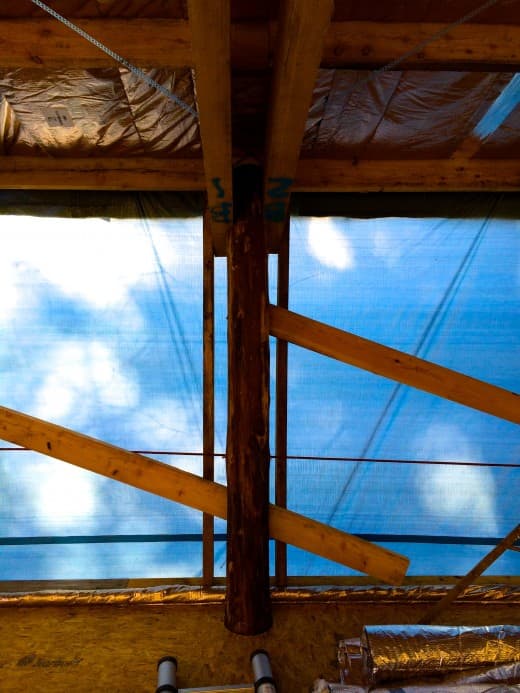
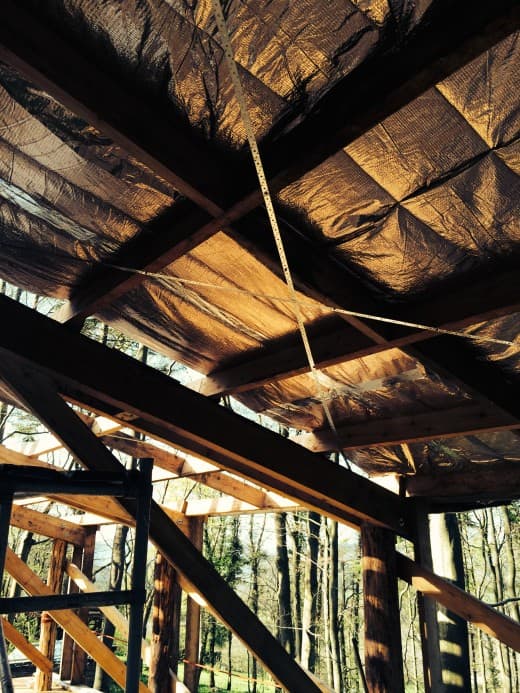
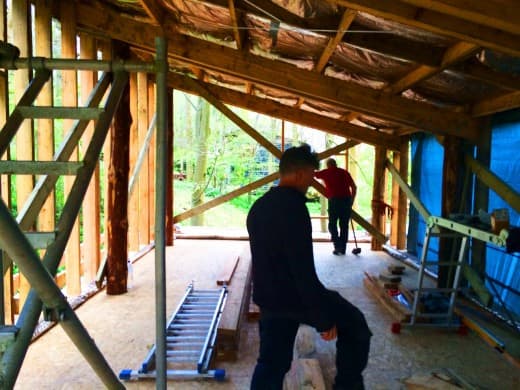
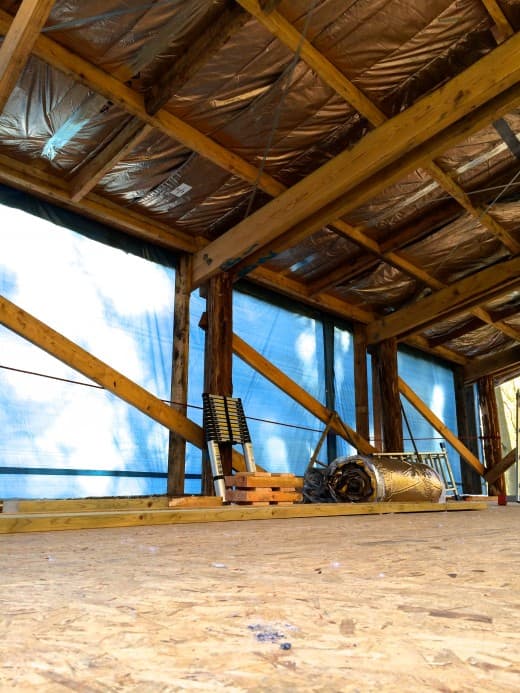
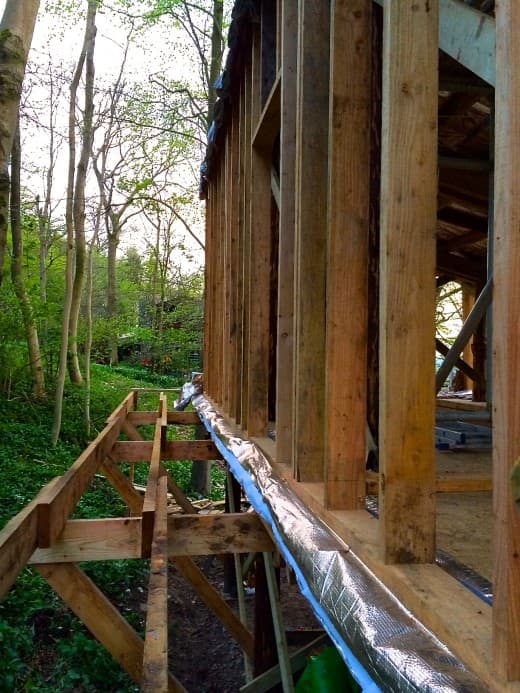
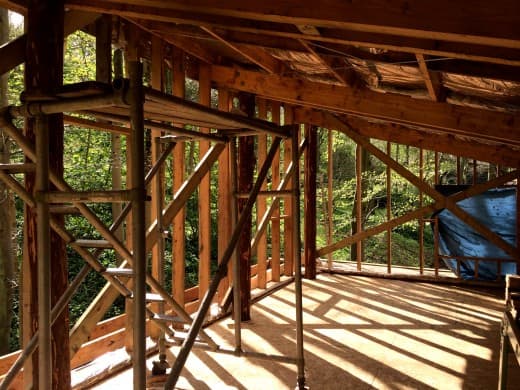
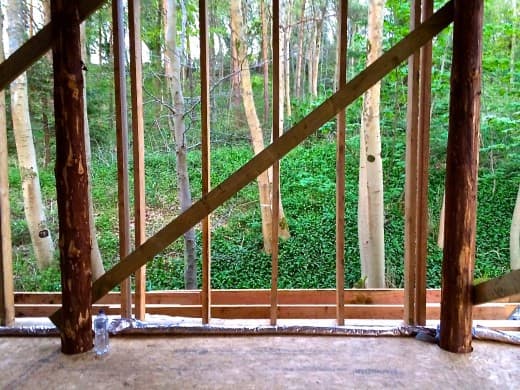 Wall framework etc all going up this week. The perimeter platform is ‘scaffolding’ which is made from our timber, and will be used in the build – nothing is wasted, and nor are we having to pay out for scaffolding hire, which can mount up. It will get removed once the walls are complete. The nature of the structure is gradually becoming more evident – it’s a ‘baggy’ secondary structure that sits around and away from the main frame, allowing you to walk between column and wall. Pretty much everything here is being exposed in the finished building – the studs are all visible, as is the silver insulation, and the flooring. I don’t have a big deal particularly about ‘honesty’ in buildings (or maybe I do, but rather, I shy away from the lazy and cod morality that often sits alongside this) but I am interested in how the process of assembly becomes the architecture. I’m interested in how the description of a building is inextricably bound up in it’s tectonic language and method of construction, rather than just an idealised description of space. What isn’t visible, yet, is the areas of transparency – or really how the building sits in the woods.
Wall framework etc all going up this week. The perimeter platform is ‘scaffolding’ which is made from our timber, and will be used in the build – nothing is wasted, and nor are we having to pay out for scaffolding hire, which can mount up. It will get removed once the walls are complete. The nature of the structure is gradually becoming more evident – it’s a ‘baggy’ secondary structure that sits around and away from the main frame, allowing you to walk between column and wall. Pretty much everything here is being exposed in the finished building – the studs are all visible, as is the silver insulation, and the flooring. I don’t have a big deal particularly about ‘honesty’ in buildings (or maybe I do, but rather, I shy away from the lazy and cod morality that often sits alongside this) but I am interested in how the process of assembly becomes the architecture. I’m interested in how the description of a building is inextricably bound up in it’s tectonic language and method of construction, rather than just an idealised description of space. What isn’t visible, yet, is the areas of transparency – or really how the building sits in the woods.
Categories
- 100k house
- Articles
- brexit
- Caretaker's House
- Christchurch
- current
- East Quay Watchet
- film
- ghost barn
- Glenn Murcutt
- Heroes
- Hooke Park
- House in an Olive Grove
- Invisible Studio
- longdrop
- Mess Building
- Moonshine
- On the Road Again
- passihvaus
- piers taylor
- piers,taylor
- press
- Projects
- Riverpoint
- Self Build
- Stillpoint
- Studio Build
- Studio in the Woods
- talks
- Trailer
- truss barn
- Uncategorized
- Vernacular Buildings
- watchet
- Westonbirt
Tags
- caretaker's house
- design and make
- Design Build Workshop
- Design Make
- east quay
- east quay watchet
- Glenn Murcutt
- green timber architecture
- Hooke Park
- Hooke Park Big Shed
- Invisible Studio
- Low Impact House
- moonshine
- Onion Collective
- piers taylor
- Piers Taylor Architect
- piers taylor invisible studio
- self build
- self build architect
- Starfall Farm
- Stillpoint Bath
- studio in the woods
- Sustainable Architecture
- The house that £100k built
- timber architecture
- Timber House
- timber workshop
- visible studio
- westonbirt architecture
- westonbirt tree management centre
